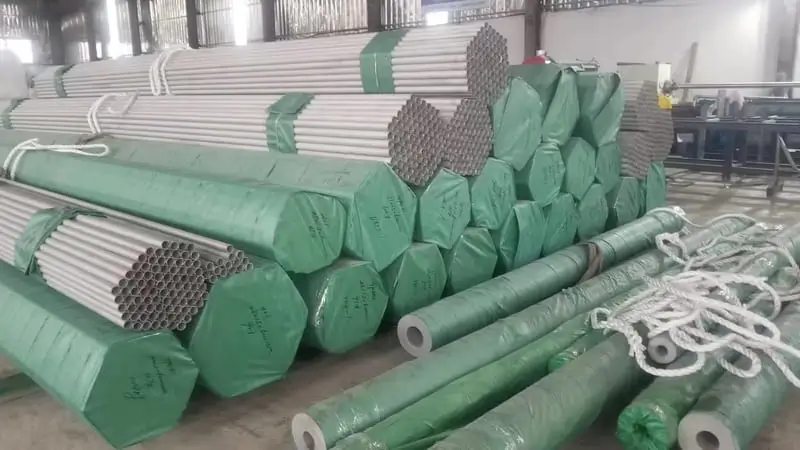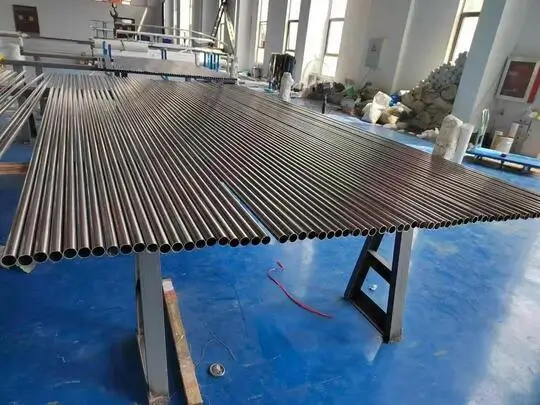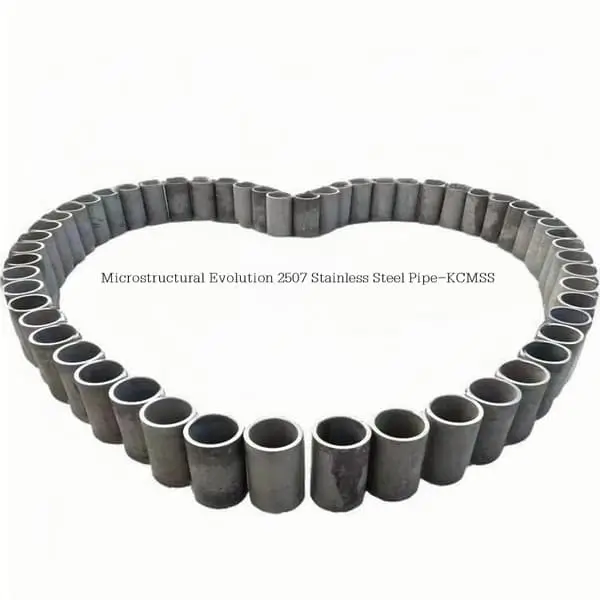Microstructural Evolution and Optimal Heat Treatment of Super Duplex 2507 Stainless Steel Pipes: A Comprehensive Analysis
Abstract
This study explores the microstructural changes, mechanical properties, and erosion-corrosion resistance of super duplex 2507 stainless steel pipes (UNS S32750, SAF2507) under varying heat treatment conditions. Through systematic experiments involving normalizing at 1050°C followed by single and double tempering within 500°C–700°C, the interplay between hardness, toughness, and anti-wear performance was rigorously analyzed. Results demonstrate that tempering at 550°C after normalizing delivers the optimal balance of mechanical and anti-corrosion properties, establishing it as the most cost-effective industrial process. The findings also address widespread public misconceptions about stainless steel, clarifying its compositional nuances and performance criteria.


1. Introduction Microstructural Evolution and Optimal Heat Treatment of Super Duplex 2507 Stainless Steel Pipe
Super duplex 2507 stainless steel pipes (SAF2507, UNS S32750) are renowned for their exceptional corrosion resistance, high strength, and durability in aggressive environments. Combining austenitic and ferritic microstructures, these pipes outperform conventional stainless steels in chloride-rich settings, making them indispensable in offshore, chemical, and marine industries. Despite their advantages, public misunderstandings about stainless steel persist, ranging from oversimplified compositional assumptions to misguided performance comparisons. This article dispels these myths while focusing on the microstructural evolution of super duplex 2507 pipes under tailored heat treatments.
2.Microstructural Evolution and Optimal Heat Treatment of Super Duplex 2507 Stainless Steel Pipe Addressing Common Misconceptions
2.1 Myth: Proliferation of Stainless Steel Grades Reflects Industrial Chaos
Fact: The diversity of stainless steel grades stems from specialized engineering demands. For example, duplex 2507 pipe excel in chloride-laden environments due to their high chromium (25%) and molybdenum (4%) content, whereas 304 stainless steel is optimized for general mechanical applications. This granularity highlights the industry’s technical precision rather than disarray.
2.2 Myth: 304/2B is the “Best” Stainless Steel
Fact: Material selection hinges on operational requirements. While 304 offers excellent formability, super duplex pipes like SAF2507 provide superior stress-corrosion cracking resistance, making them ideal for subsea pipelines and chemical reactors.
2.3 Myth: Nickel is the Primary Corrosion-Resistant Element
Fact: Chromium (≥12%) is essential for forming a passive Cr₂O₃ oxide layer. Nickel primarily stabilizes austenitic structures but is absent in ferritic/martensitic steels (e.g., 400 series), which still resist corrosion through chromium.
2.4 Myth: Stainless Steel Contains Only Fe, Ni, Cr, and C
Fact: Advanced grades incorporate alloying elements like copper (antibacterial properties), molybdenum (pitting resistance), and nitrogen (strength enhancement) to meet specific operational challenges.
3.Microstructural Evolution and Optimal Heat Treatment of Super Duplex 2507 Stainless Steel Pipe Material and Experimental Methodology
3.1 Material Composition
The super duplex 2507 pipe (SAF2507) composition is detailed below:
Table 1: Chemical Composition of Super Duplex 2507 (wt%)
| Element | Cr | Ni | Mo | N | Fe |
|---|---|---|---|---|---|
| Content | 25% | 7% | 4% | 0.3% | Bal. |
3.2 Heat Treatment Process
Normalizing: 1050°C for 1 hour, air-cooled to induce martensitic transformation.
Tempering: Single and double tempering at 500°C, 550°C, 600°C, 650°C, and 700°C for 2 hours per cycle.
3.3 Characterization Techniques
Microstructural Analysis: TEM and SEM for reverted austenite observation.
Mechanical Testing: Vickers hardness (ASTM E384), Charpy impact tests (ASTM E23).
Erosion-Corrosion Testing: Slurry erosion apparatus (ASTM G119) with 30 wt% silica sand, 4 m/s flow velocity.
4.Microstructural Evolution and Optimal Heat Treatment of Super Duplex 2507 Stainless Steel Pipe Results and Analysis
4.1 Microstructural Evolution and Optimal Heat Treatment of Super Duplex 2507 Stainless Steel Pipes Microstructural Evolution
Reverted Austenite Formation: During 550°C–650°C tempering, dark elongated/blocky reverted austenite phases (100–1000 nm) nucleate at martensite boundaries (Fig. 1).
Phase Transformation at 700°C: Nickel diffusion reduces segregation, enabling reverted austenite to transform into fresh martensite upon cooling.
Table 2: Phase Distribution vs. Tempering Temperature
| Tempering (°C) | Reverted Austenite (%) | Fresh Martensite (%) |
|---|---|---|
| 500 | 0 | 95 |
| 550 | 15 | 80 |
| 600 | 20 | 75 |
| 650 | 18 | 77 |
| 700 | 2 | 93 |
4.2Microstructural Evolution and Optimal Heat Treatment of Super Duplex 2507 Stainless Steel Pipes Mechanical Properties
Table 3: Hardness and Toughness After Heat Treatment
| Tempering (°C) | Hardness (HV) – Single Tempering | Hardness (HV) – Double Tempering | Impact Toughness (J/cm²) |
|---|---|---|---|
| 500 | 420 | 405 | 45 |
| 550 | 390 | 375 | 75 |
| 600 | 370 | 355 | 70 |
| 650 | 360 | 345 | 65 |
| 700 | 410 | 395 | 50 |
Hardness Trend: Declines initially (500°C–650°C) due to austenite softening, then rebounds at 700°C from fresh martensite.
Toughness Peak: 550°C tempering maximizes toughness (75 J/cm²) via austenite-induced ductility.
4.3Microstructural Evolution and Optimal Heat Treatment of Super Duplex 2507 Stainless Steel Pipes Erosion-Corrosion Performance
Table 4: Cumulative Weight Loss (g) Over Time
| Tempering (°C) | 24 Hours | 48 Hours | 72 Hours | Total Loss (g) |
|---|---|---|---|---|
| 500 | 1.2 | 2.5 | 3.8 | 7.5 |
| 550 | 0.8 | 1.6 | 2.4 | 4.8 |
| 700 | 1.5 | 3.0 | 4.5 | 9.0 |
- Optimal Resistance: 550°C-tempered samples exhibit minimal weight loss (4.8 g), attributed to balanced hardness (390 HV) and toughness.
5. Discussion Microstructural Evolution and Optimal Heat Treatment of Super Duplex 2507 Stainless Steel Pipes
5.1 Role of Reverted Austenite
Reverted austenite enhances toughness but reduces hardness due to its softer FCC structure. At 550°C, a 15% austenite content optimally balances these properties.
5.2 Economic Implications of Double Tempering
Double tempering marginally reduces hardness without improving erosion resistance, rendering it economically unjustified for industrial applications.
5.3 Industrial Relevance of 550°C Tempering
The 550°C regimen aligns with cost-efficiency and performance demands, making it ideal for offshore pipelines and desalination plants.
6. Conclusion Microstructural Evolution and Optimal Heat Treatment of Super Duplex 2507 Stainless Steel Pipes
The study establishes 1050°C normalizing followed by single tempering at 550°C as the optimal heat treatment for super duplex 2507 pipes (SAF2507). This protocol maximizes erosion-corrosion resistance while maintaining mechanical integrity. Double tempering offers negligible benefits, and higher temperatures (>650°C) degrade performance due to martensite embrittlement. These insights empower industries to optimize material selection and processing for harsh environments.
FAQ Section Microstructural Evolution and Optimal Heat Treatment of Super Duplex 2507 Stainless Steel Pipe
Q1: Can super duplex 2507 pipes replace titanium in offshore applications?
Yes—their high pitting resistance equivalence (PREN >40) rivals titanium at a lower cost.
Q2: Why does hardness dip at 550°C–650°C tempering?
Reverted austenite’s FCC structure softens the matrix, reducing hardness but enhancing fracture resistance.
Q3: How does SAF2507 differ from standard duplex grades?
SAF2507 contains higher Cr, Mo, and N, offering superior strength and chloride resistance.
Q4: Is post-weld heat treatment necessary for 2507 pipes?
Yes—to restore corrosion resistance by dissolving deleterious intermetallic phases.

